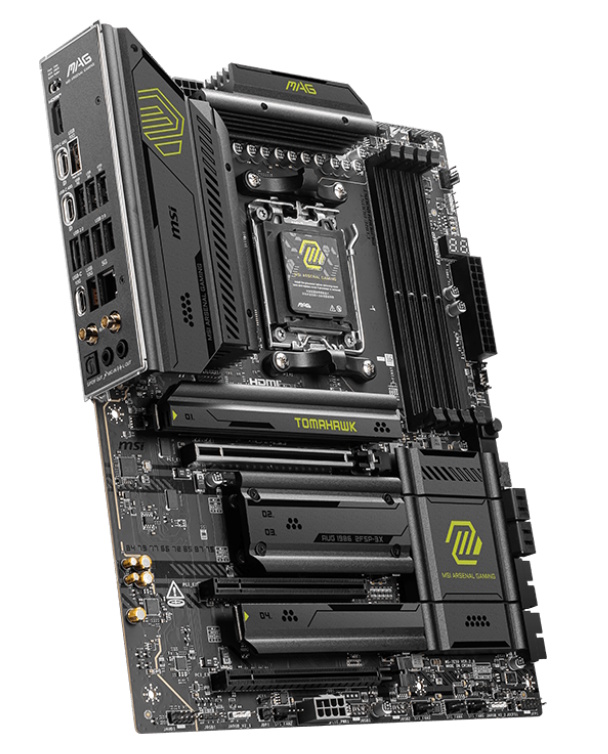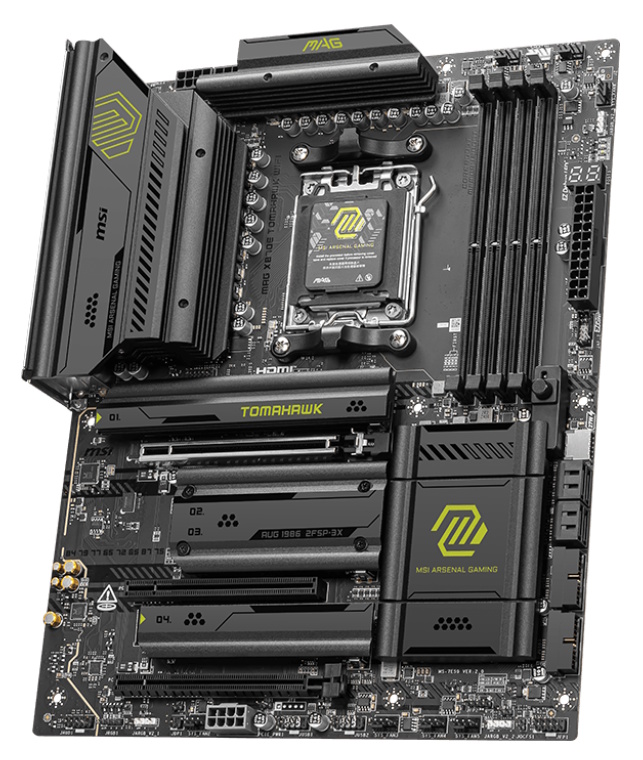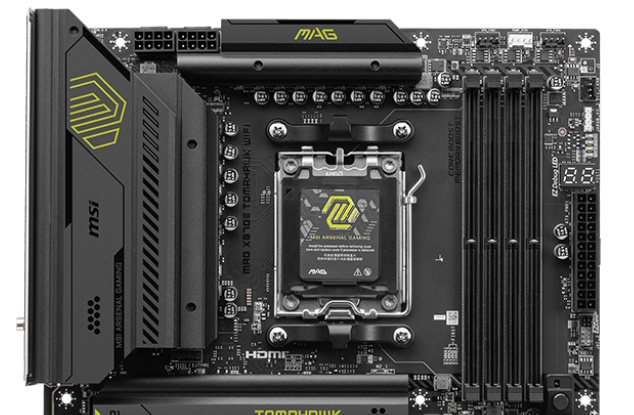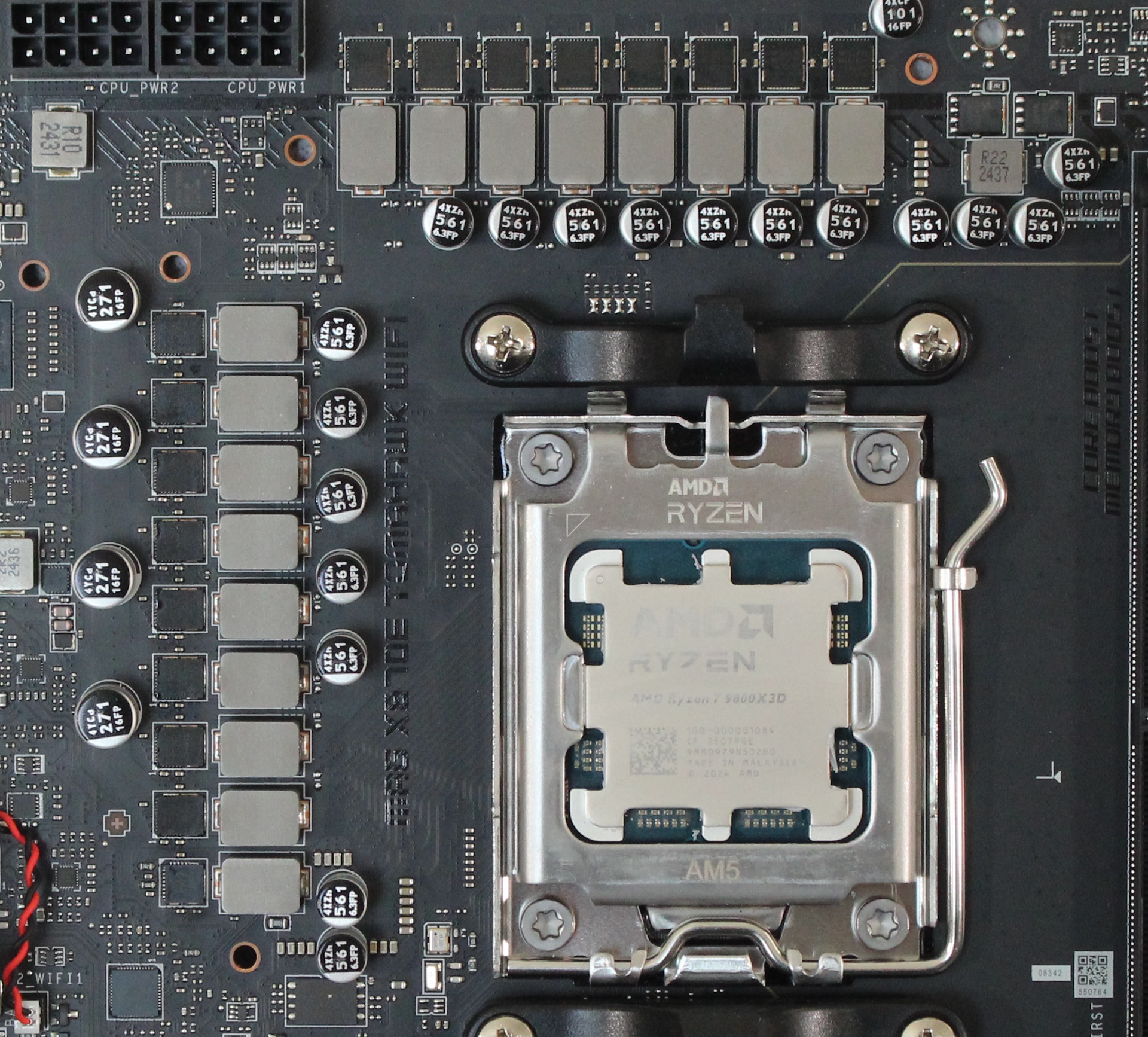Tom's Hardware Verdict
MSI’s X870E Tomahawk WiFi is a well-rounded sub-$400 offering, featuring a wide variety of capabilities, including 40 Gbps Ports, capable power delivery, EZ DIY, and AI features. It doesn’t stand out as the best among its peers, but it is certainly a viable option in the space.
Pros
- +
3x Type-C ports (2x 40 Gbps) on rear IO
- +
EZ DIY features
- +
Click BIOS X
- +
Performs well
Cons
- -
Standard appearance
- -
No integrated RGB
Why you can trust Tom's Hardware
Recently, we reviewed MSI’s B850 Tomahawk MAX Wifi and came away impressed, giving praise for its budget-friendly price (under $230) and well-rounded specifications. The X870E version on the test bench adds some tangible features, but it otherwise appears identical and shares the same specifications, albeit at a dramatically different price.
For hardware, MSI includes integrated Wi-Fi 7 and 5 GbE networking, as well as three Type-C ports on the rear I/O, two of which run at 40 Gbps (USB4). Storage includes four M.2 sockets (two PCIe 5.0 x4) and four SATA ports. Realtek’s ALC4080 codec handles audio duties and is common at this price point. The rugged military-style appearance is pleasing, but it isn’t my favorite in this range. MSI’s EZ Features are comparable to those of other boards. I especially like the ‘nub’ M.2 holders and the ease with which you can attach and detach the heatsinks.
During testing, we updated the BIOS to AGESA 1.2.0.3c, the latest from AMD. Besides enabling the memory’s EXPO profile, we used the default settings. Results showed that the board was competent across all tests. It performed well in our game testing, achieving an average rating overall, excelling in some tests, and slightly underperforming in others. As is typical, all the results are close, and in most cases, you wouldn’t notice a difference without a frame counter or timer on your screen.
Below, we’ll examine the board's details and determine whether it deserves a spot on our Best Motherboards list. However, before we share the test results and discuss the details, the specifications from MSI are provided below.
Specifications of the MSI MAG X870E Tomahawk Wifi
Socket | AM5 (LGA 1718) |
Chipset | X870E |
Form Factor | ATX |
Voltage Regulator | 17 Phase (14x 80A SPS MOSFETs for Vcore) |
Video Ports | (1) HDMI (v2.1) |
| Row 5 - Cell 0 | (2) DisplayPort (v1.4, Type-C) |
USB Ports | (2) USB 4.0 (40 Gbps) Type-C |
| Row 7 - Cell 0 | (1) USB 3.2 Gen 2 (10 Gbps) Type-C |
| Row 8 - Cell 0 | (2) USB 3.2 Gen 2 (10 Gbps) |
| Row 9 - Cell 0 | (3) USB 3.2 Gen 1 (5 Gbps) |
| Row 10 - Cell 0 | (4) USB 2.0 (480 Mbps) |
Network Jacks | (1) 5 GbE |
Audio Jacks | (2) Analog + SPDIF |
Legacy Ports/Jacks | ✗ |
Other Ports/Jack | ✗ |
PCIe x16 | (1) v5.0 (x16) |
| Row 16 - Cell 0 | (1) v4.0 (x4) |
| Row 17 - Cell 0 | (1) v3.0 (x1) |
PCIe x8 | ✗ |
PCIe x4 | ✗ |
PCIe x1 | ✗ |
CrossFire/SLI | ?? |
DIMM Slots | (4) DDR5-8400(OC), 256GB Capacity |
| Row 23 - Cell 0 | • 1DPC 1R Max speed up to 8400+ MT/s |
| Row 24 - Cell 0 | • 1DPC 2R Max speed up to 6400+ MT/s |
| Row 25 - Cell 0 | • 2DPC 1R Max speed up to 6400+ MT/s |
| Row 26 - Cell 0 | • 2DPC 2R Max speed up to 4800+ MT/s |
M.2 Sockets | (2) PCIe 5.0 x4 (128 Gbps) / PCIe (up to 110/80mm) |
| Row 28 - Cell 0 | (2) PCIe 4.0 x4 (64 Gbps) / PCIe (up to 80mm) |
| Row 29 - Cell 0 | Supports RAID 0/1/5/10 |
SATA Ports | (4) SATA3 6 Gbps (Supports RAID 0/1/10) |
USB Headers | (1) USB v3.2 Gen 2x2 (20 Gbps) Type-C |
| Row 32 - Cell 0 | (2) USB v3.2 Gen 2 (5 Gbps) |
| Row 33 - Cell 0 | (2) USB v2.0 (480 Mbps) |
Fan/Pump Headers | (8) 4-Pin (Accepts PWM and DC) |
RGB Headers | (3) aRGB (3-pin) |
| Row 36 - Cell 0 | (1) RGB (4-pin) |
Diagnostics Panel | (1) Post Status Checker (4 LEDs) |
| Row 38 - Cell 0 | (1) 2-character Debug LED |
Internal Button/Switch | EZ Debug LED (4) |
| Row 40 - Cell 0 | EZ Memory Detection LED |
SATA Controllers | ✗ |
Ethernet Controller(s) | (1) Realtek 8126VB (5 GbE) |
Wi-Fi / Bluetooth | Wi-Fi 7 - 320 MHz, 6 GHz, 5.8 Gbps, BT 5.4 |
USB Controllers | ASMedia ASM4242, Genesys Logic GL850G |
HD Audio Codec | Realtek ALC4080 |
DDL/DTS | ✗ / ✗ |
Warranty | 3 Years |
Inside the Box of the MSI X870E Tomahawk Wifi
MSI includes a few accessories to get your started. You get two SATA cables, an M.2 Plate screw, EZ M.2 Clip removal tool, EZ Front Panel, 1 to 3 EZ Conn-Cable, and the EZ Wi-Fi antenna. Last, there is the Quick Installation Guide, cable stickers, and a USB drive with drivers. Nothing extraordinary.
Design of the Tomahawk Wifi



The X870E Tomahawk Wifi, like B850 Tomahawk MAX Wifi, sits on a black 8-layer server-grade PCB with large heatsinks covering the VRM and plate-style heatsinks tasked to cool the M.2 sockets and chipset. Breaking up the all-black look are bright yellow-green highlights with the MAG symbol and the Tomahawk/Arsenal Gaming branding on the rest of the heatsinks. Those hoping for integrated RGB lighting need to look elsewhere, as none are built-in (there are headers you can use). We liked the look as a budget motherboard, but wish it had some upgrades for the higher-priced X870E version.

In the upper-left corner are two 8-pin EPS connectors (one required) for the processor. Surrounding them are the Frozr Design VRM heatsinks, with a matte-black finish and MSI branding. The large heatsinks have plenty of surface area and mass to keep the power delivery within spec, even with a flagship-class (higher-wattage) processor and PBO.
Get Tom's Hardware's best news and in-depth reviews, straight to your inbox.
Right of the socket, we find the four DRAM slots with locking mechanisms on both sides. MSI supports up to 256GB of RAM with speeds listed to DDR5-8400+, which is plenty fast for the platform. Unlike the B850, we couldn’t boot to DDR5-8000, but DDR5-7200 ran our 30-minute stress test without issue as we expected.
Above the RAM slots are the first three (of seven) 4-pin fan headers. CPU_Fan1, PUMP_Sys1, and SYS_Fan1 specifically, from left to right. Each header supports PWM and DC-controlled devices. Output varies depending on the header, with the system fan headers rated at 1A/12W, the CPU fan at 2A/24W, and the pump, which is the most powerful, able to output 3A/36W. Fan control is handled through the MSI Center software and the User Scenario applet.
Looking at the right edge and moving down, we encounter another 4-pin fan header and the first 3-pin ARGB header (the other ARGB/RGB headers are located on the bottom edge). Control over any RGBs you add is handled through the Mystic Light portion of MSI Center (detailed below in the software section).
Below are the four EZ Debug LEDs that light up during the POST process. If there’s a problem in one of the areas (Boot, DRAM, VGA, CPU), the colored LED for the trouble spot remains lit, giving some insight into where the problem is. Next is the 24-pin ATX power connector for the board, and finally, the convenient EZ-Conn-Header V2 that allows you to connect ARGB strips, fans, USB 2.0 devices, and even their MPG EZ120 ARGB fans from a single cable.

Power delivery on the Tomahawk Wifi consists of 17 phases, 14 of which are dedicated to Vcore. Power starts at the 8-pin EPS connector(s) and routed to a Monolithic Power Systems (MPS) MPS2412 controller. From there, it moves to the 80A MPS MPS2433 SPS MOSFETs. The 1,120A is more than enough for even flagship-class processors, such as the Ryzen 9 7950X or the most recent 9950X. While they aren’t the most robust we’ve seen, especially for X870E, they won’t hold you back, even with PBO or manual overclocking.

On the bottom side of the board, on the left, is a fully exposed audio solution featuring the Realtek ALC4080 chip along with several dedicated audio capacitors and signal isolation from the rest of the board. It’s a suitable audio solution that should meet the needs of most users.
In the middle are three full-length PCIe slots and four M.2 sockets. The top slot, PCI_E1, uses MSI’s PCIe Armor and EZ PCIe Release, offering additional support and easy access for removal. It connects through the CPU and is your primary graphics slot at PCIe 5.0 x16. The bottom two full-length slots (PCI_E2/3) connect through the chipset. The middle slot is the slowest, running at PCIe 3.0 x1, while the bottom is PCIe 4.0 x4. 3.0 x1 feels slow these days, where it’s common to see 4.0 x4 or greater; however, few will likely need it, or should use the other slot for high-bandwidth needs.
For M.2 storage, the first M. 2 socket, M2_1, is just above the top PCIe slot. It runs at PCIe 5.0 x4 (128 Gbps). The heatsink isn’t the biggest we’ve seen, so if you plan to run extended transfers with a hot-running 5.0-based drive, keep an eye on temperatures. Surprisingly, M.2_2 also runs at PCIe 5.0 x4, so you have two ultra-fast M.2 drives. M.2_4 supports up to PCIe 4.0 x4, while the M.2_3, which borrows lanes from the bottom PCIe slot, runs up to PCIe 4.0 x2. Also worth noting: M2_2 shares bandwidth with the 40 Gbps USB ports. Both run at PCIe 5.0 x2 (equal to 4.0 x4) when M2_2 is populated. You can force the socket to x4, but that disables the 40 Gbps Type-C ports.
Shifting focus to the right edge, there are a few connectors. Starting at the top are the front panel USB-C 3.2 Gen 2x2 (20 Gbps) connector, four SATA ports, and two 19-pin front panel USB 3.2 Gen 1 (5 Gbps) connectors.
Across the bottom are several useful headers. From left to right:
- Front Panel audio
- 4-pin RGB, 3-pin ARGB
- 2-pin Chassis Intrusion
- 4-pin System Fan header
- 8-pin Supplemental PCIe power
- (2) USB 2.0 headers
- (3) 4-pin System Fan headers
- 3-pin ARGB header
- 2-pin Clear CMOS jumper
- Front Panel

Starting on the left side of the rear IO are two tiny buttons: one for clearing the CMOS and the other for BIOS Flashback. Next to that is the HDMI port to use with integrated graphics. There are three USB Type-C ports, two of which support 40 Gbps and one supports 10 Gbps. You also get two 10 Gbps (red), four 5 Gbps (blue), and four USB 2.0 (black) Type-A ports. Above one of the red USB ports is the Realtek 5 Gbps Ethernet. Next are the two Wi-Fi 7 connections and the audio stack, with two 3.5mm (mic in/line out) and SPDIF.
MORE: Best Motherboards
MORE: How To Choose A Motherboard
MORE: All Motherboard Content

Joe Shields is a staff writer at Tom’s Hardware. He reviews motherboards and PC components.
-
das_stig Stop saying having a standard appearance and no integrated RGB as a CON.Reply
Many users don't want this rubbish and by TH "journalists" ( yeh it took me a few goes to type that without peeing my pants laughing), trying to enforce their own bias preferences shows them to be arrogant. -
JayGau Reply
Calm down. If the reviewer likes RGB on his motherboard then it's a con for him. Reviews are subjective, especially when it comes to anesthetics.das_stig said:Stop saying having a standard appearance and no integrated RGB as a CON.
Many users don't want this rubbish and by TH "journalists" ( yeh it took me a few goes to type that without peeing my pants laughing), trying to enforce their own bias preferences shows them to be arrogant.
This hatred for RGB is becoming laughable. Being so aggressive over it is close to psychosis. Rubbish, peeing your pants, bias preferences, arrogant. WOW! Do you feel like some kind of special genius because you are on the "we hate RGB" team? If you don't like it then get the non-RGB version and enjoy your sad build. No need to insult people who do like some colors on their PC. -
JeffreyP55 Reply
I do not like my PC looking like a huge xmas ornament either. Some do. Just let it go MMMkay?das_stig said:Stop saying having a standard appearance and no integrated RGB as a CON.
Many users don't want this rubbish and by TH "journalists" ( yeh it took me a few goes to type that without peeing my pants laughing), trying to enforce their own bias preferences shows them to be arrogant. -
wussupi83 It's not a bad board. I don't mind not having RGB. I like how easy it is to swap out the primary SSD. The default audio chip is pretty good. Decent number of fan headers. I don't like the orientation of the front panel USB C header. Seems to OC just fine. Motherboards sure seem expensive these days.Reply -
SSGBryan Reply
Not just them.JayGau said:Calm down. If the reviewer likes RGB on his motherboard then it's a con for him. Reviews are subjective, especially when it comes to anesthetics.
This hatred for RGB is becoming laughable. Being so aggressive over it is close to psychosis. Rubbish, peeing your pants, bias preferences, arrogant. WOW! Do you feel like some kind of special genius because you are on the "we hate RGB" team? If you don't like it then get the non-RGB version and enjoy your sad build. No need to insult people who do like some colors on their PC.
Every penny and every moment spent on RGB is a penny & time that could have been spent on performance.
More important to me is the lack of PCIe slots.
This is why I am still on AM4. -
JayGau Reply
Again, nobody is forcing you to pay for it and spend time on it. For me the extra cost of RGB is insignificant (it certainly doesn't prevent me to get better hardware just because I spend a few extra bucks on RGB) and the time spent on it is part on the fun. This RGB trend is becoming a RGB hatred trend that people seem to embrace just to feel like they belong to some sort of wise tribe that makes them feel special.SSGBryan said:Not just them.
Every penny and every moment spent on RGB is a penny & time that could have been spent on performance.
More important to me is the lack of PCIe slots.
This is why I am still on AM4. -
JeffreyP55 Reply
I never really cared for my PC looking like a Las Vegas attraction. It will all end someday. In the meantime, have fun. It's your money!JayGau said:Again, nobody is forcing you to pay for it and spend time on it. For me the extra cost of RGB is insignificant (it certainly doesn't prevent me to get better hardware just because I spend a few extra bucks on RGB) and the time spent on it is part on the fun. This RGB trend is becoming a RGB hatred trend that people seem to embrace just to feel like they belong to some sort of wise tribe that makes them feel special. -
das_stig Reply
Calm down dear I was only having a bit of sarcastic fun, jeez. A reviewer like any journalist should not take sides based on his own preferences, just report the features and let the reader decide if a plus or minus.JayGau said:Calm down. If the reviewer likes RGB on his motherboard then it's a con for him. Reviews are subjective, especially when it comes to anesthetics.
This hatred for RGB is becoming laughable. Being so aggressive over it is close to psychosis. Rubbish, peeing your pants, bias preferences, arrogant. WOW! Do you feel like some kind of special genius because you are on the "we hate RGB" team? If you don't like it then get the non-RGB version and enjoy your sad build. No need to insult people who do like some colors on their PC. -
Garden-Gnome FWIW I can't stand all the RGB bling either. If you really want to watch all the flashing lights go to TNMOC when the Harwell Dekatron is running. At least the lights on the Dekatron have a meaning.Reply -
MirakuruIV Does the X870E Tomahawk use the Qualcomm Fast-Connect 7800 or the Qualcomm Fast-Connect 7900, Im asking this because I have had issues with the 7800Reply
